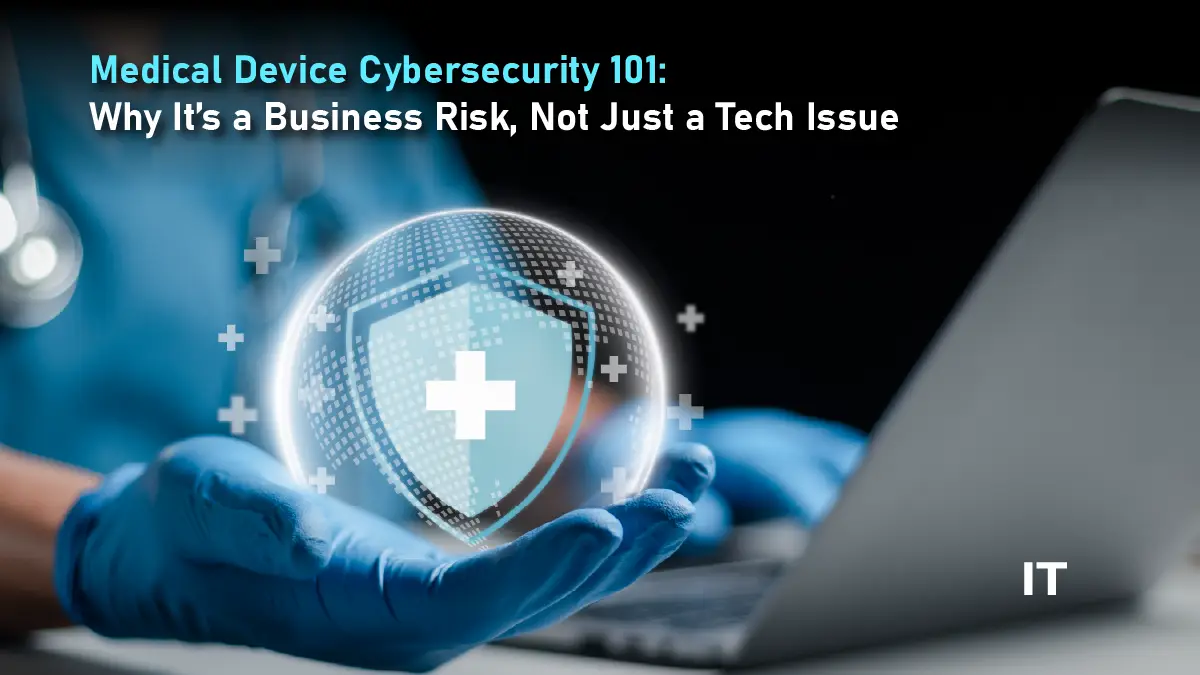Medical device cybersecurity is no longer just IT risk management. It’s an operational function with direct consequence on continuity of operation, regulatory adherence, reputation and financial success. As interconnected medical devices become integral to clinical practice and patient monitoring, they are exposed to more cyber threats. For manufacturers, providers and third-party services partners, remediation of these risks is not merely a technical imperative, it’s a business imperative to guard revenue and stakeholder confidence.
This article looks at the business risks of medical device cybersecurity failures including legal exposure, reputational damage and competitive disadvantage. It also explores how proactive cybersecurity governance is becoming a differentiator in market access and enterprise valuation.
The Expanding Attack Surface for Connected Devices
The integration of Internet of Medical Things (IoMT) devices across healthcare environments has expanded the digital attack surface. Devices such as infusion pumps, patient monitors, diagnostic imaging equipment and wearable sensors are being connected to hospital networks, cloud platforms and mobile applications.
Each connection point is a possible point of entry for attackers. Attackers can use old firmware, poor authentication protocols or lack of data encryption to breach devices. In the worst-case scenario a breach can disable device operation, interfere with patient care or provide access to patient health information (PHI).
As threats increase in sophistication the monetary and reputational expense of a successful attack increases. Medical device cyber-attacks are not science fiction, they have been reported, dissected and in a few instances have resulted in recalls and regulatory attention.
Financial Exposure from Downtime and Legal Liability
Medical device cybersecurity failures can result in revenue loss across multiple dimensions. If a connected device is compromised its availability may be suspended until vulnerabilities are patched. In high dependency clinical settings this means workflow disruption, delayed treatments and loss of billable procedures.
In parallel healthcare providers and manufacturers face legal exposure. A device breach causing patient injury or unauthorized release of data can result in litigation, fines and compliance penalties under HIPAA, GDPR or state health data protection legislation. These expenses are compounded by internal investigations, remediation initiatives and reputational harm.
For device manufacturers vulnerabilities discovered post market can trigger costly product recalls, regulatory audits and market access restrictions. In some cases, cybersecurity deficiencies can delay FDA approvals or disrupt clinical adoption affecting revenue forecasts and shareholder confidence.
June 2025 – RunSafe Security, a U.S.-based cybersecurity firm released its 2025 Medical Device Cybersecurity Index. The report found 22% of healthcare organizations had incidents involving connected medical devices, 75% of them increased their OT security budgets and only 17% are confident in their current defenses. 83% of organizations now include cybersecurity in procurement processes and 80% are willing to pay a premium for devices with built in security. This is a clear sign that cybersecurity is no longer an afterthought but a key factor in purchasing decisions and patient safety in modern healthcare.
Incident Response Delays Multiply Business Impact
When device security incidents happen, the speed and clarity of the response has a direct impact on business recovery. Yet many manufacturers don’t have a structured response framework or real-time visibility into deployed devices. Without instant knowledge of which models, customers or software versions are impacted, organisations face delayed disclosure, extended downtime and increased wider financial exposure. Delayed response in some instances can result in legal non-compliance with obligations, regulatory fines, and only serves to further damage customer confidence and increase the cost of recovery compared with the breach.
Procurement Teams Now Consider Cybersecurity a Core Evaluation Criteria
Hospital procurement is changing. Clinical performance and cost are no longer the only decision metrics. Security posture is becoming a key filter and many health systems are requiring documented cybersecurity readiness before purchase. This includes vulnerability management policies, incident reporting workflows and integration with existing security infrastructure. Manufacturers who can’t meet these requirements may lose access to institutional buyers or face longer sales cycles due to repeated risk reviews. This shifts cybersecurity from a back office function to a go to market requirement and impacts sales velocity and long term competitiveness.
Legacy Devices are a Persistent Source of Exposure
Many organisations are still using legacy medical devices that lack modern security controls. These devices are still clinically functional but run on unsupported operating systems, have hardcoded credentials or no patching mechanism at all. For providers, maintaining these assets means long term exposure to preventable risk. For producers, open vulnerabilities in older products can present lingering liability even if the devices are out of production. Visionary organisations are therefore initiating phased remediation plans, ranging from network segmentation to controlled decommissioning, in an effort to mitigate their inherited risk profile and prevent unplanned downtime or incident response expenses.
Also Read: Cybersecurity in Connected Care: Securing IoT in the Healthcare Ecosystem
Brand and Market Access Risks
In an industry built on trust and clinical precision, cybersecurity breaches have disproportionate brand consequences. Healthcare buyers and institutional partners are now evaluating cybersecurity as part of procurement and long term vendor partnerships. A breach tied to a medical device can erode provider trust and create long term reputational damage that’s hard to recover from.
Brand value in the medical device sector is tied to safety, reliability and regulatory alignment. A company known for lax cybersecurity can lose competitive positioning in high growth segments especially in diagnostics, remote care and digital therapeutics. This reputational damage doesn’t just affect sales, it can impact talent acquisition, investor sentiment and strategic partnerships.
Regulatory Scrutiny and Evolving Compliance Expectations
Governments and regulatory agencies are taking a more aggressive stance on medical device cybersecurity. In key markets like the US, the FDA now requires manufacturers to submit cybersecurity documentation as part of the premarket submission process. The FDA’s recent guidance outlines expectations for threat modeling, patch management, access controls and software bill of materials (SBOM) disclosures.
Noncompliance is no longer a minor deficiency. It can lead to approval delays or post market enforcement actions. The EU’s Medical Device Regulation (MDR) and Cyber Resilience Act impose cybersecurity responsibilities throughout the product lifecycle.
For global manufacturers, the cost of meeting these requirements is justified by the revenue risk of not meeting them. Cybersecurity maturity has become a prerequisite for regulatory success and long term market participation.
Cybersecurity as a Competitive Advantage
While the threat of cybersecurity risks is enormous in terms of downside exposure, a successful cybersecurity strategy can also generate value. Companies that bet on secure by design architectures, open vulnerability disclosure programs and real-time threat monitoring can become trusted partners to regulators, insurers and hospitals.
This trust translates into preferred vendor status, faster procurement cycles and stronger long term customer relationships. For digitally enabled care models like remote patient monitoring and virtual diagnostics, robust cybersecurity can become part of the value proposition.
Cybersecurity certifications and industry benchmarks are also influencing purchasing decisions. Companies that proactively demonstrate compliance with industry standards like ISO/IEC 27001, UL 2900 or NIST guidelines get faster access to hospital networks and payer ecosystems.
In May 2025, Medcrypt launched its Medical Device Product Security Intelligence Platform to help manufacturers proactively assess cybersecurity risks across the product lifecycle. The platform allows teams to quantify security threats in financial terms, prioritize vulnerabilities and generate remediation plans aligned to regulatory expectations. As cybersecurity becomes part of compliance and market access, tools like this are a sign of the shift from reactive security to value driven governance.
Security in Device Design from the Start
Medical device security can’t be an afterthought. To reduce lifecycle vulnerabilities, manufacturers are embedding security into the product development process. This means secure coding standards, formal threat modeling and penetration testing before a device hits the market.
Secure-by-design approaches encrypt data in transit and at rest, authentication for user access and safeguards to prevent tampering or unauthorized firmware updates. These technical controls are documented and tested to regulatory expectations, so you don’t have to do costly redesigns or post-launch patching.
By shifting security left in the development cycle, you reduce the need for reactive fixes and build market confidence in your product.
Post-Market Surveillance and Patch Management
A big part of medical device security is ongoing monitoring and vulnerability management. Even after launch, devices need continuous updates to address new threats that may emerge months or even years later.
Firms are spending money on patch delivery infrastructure in order to make secure and timely updates, particularly for equipment in the hospital setting where uptime is the priority. Remote update functionality with device telemetry allow detecting anomalies prior to them becoming incidents.
Concurrently, coordinated vulnerability disclosure programs enable third-party researchers to responsibly and safely report issues. Such programs are evidence of maturity and transparency and benefit your reputation among regulators and customers.
Cross-Functional Ownership and Risk Governance
Security isn’t just an IT problem. Effective programs span multiple domains, engineering, legal, compliance, product and executive leadership. Leading manufacturers have formalized cross-functional governance to oversee security strategy, incident response and regulatory alignment.
These governance models assign ownership for key tasks, from managing SBOMs to assessing third-party software risks. Boards and leadership teams are getting regular briefings on security risk exposure so they can tie technical vulnerabilities to financial impact.
In healthcare delivery organizations, biomedical engineers, IT security teams and clinical operations work together to ensure device usage doesn’t expose broader systems to compromise. This integrated governance framework recognizes security is not just a technical issue, it’s a business-wide priority.
Supply Chain Dependencies
Modern medical devices rely on complex supply chains with third-party software, hardware components and external development partners. These interdependencies expand the attack surface. Without visibility into the entire ecosystem, you may unknowingly ship devices with inherited vulnerabilities. To fix this, companies are doing more due diligence on suppliers and requiring secure development practices across the chain. Software bill of materials (SBOM) tracking, vendor risk scoring and supplier audits are being added to procurement workflows.
This supply chain visibility is important for security but also for compliance with regulations that now require documentation of third-party software components and their risks.
Cybersecurity as a Value Driver
The medical device industry is at a point where cybersecurity maturity is directly tied to revenue, brand and long term market access. As healthcare delivery models move towards connectivity, interoperability and data driven care any weakness in device security is a business liability.
But organizations that treat cybersecurity as a value generating capability, investing in design controls, transparent reporting and cross functional readiness are turning compliance into competitive advantage.
Rather than seeing it as a cost center, forward thinking companies are integrating cybersecurity into product roadmaps, go to market strategies and stakeholder communications. By doing so they not only reduce breach risk but also customer loyalty and adoption.
Conclusion
In today’s connected world of healthcare, medical device cybersecurity is no longer just a technical issue. It impacts clinical continuity, brand reputation, market access and long term financial performance. Medical device vulnerabilities can disrupt patient care, erode stakeholder trust and block commercial growth. By reframing cybersecurity as a business risk, medical device manufacturers and healthcare providers can approach it strategically. This means integrating security into product design, aligning to regulatory frameworks, supporting customer assurance and operational resilience. Those that do this across their ecosystem will be better placed to protect revenue, patients and lead in a digital healthcare world.
































